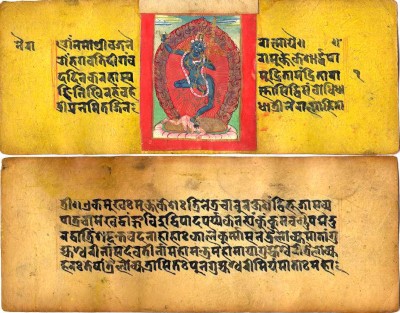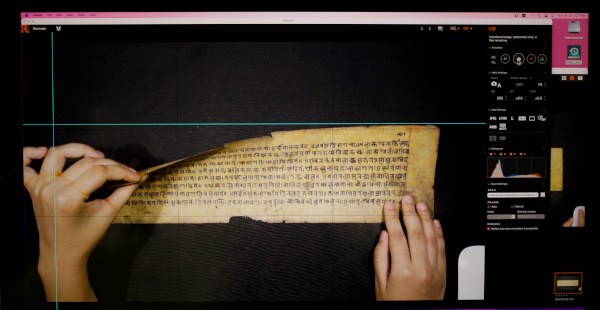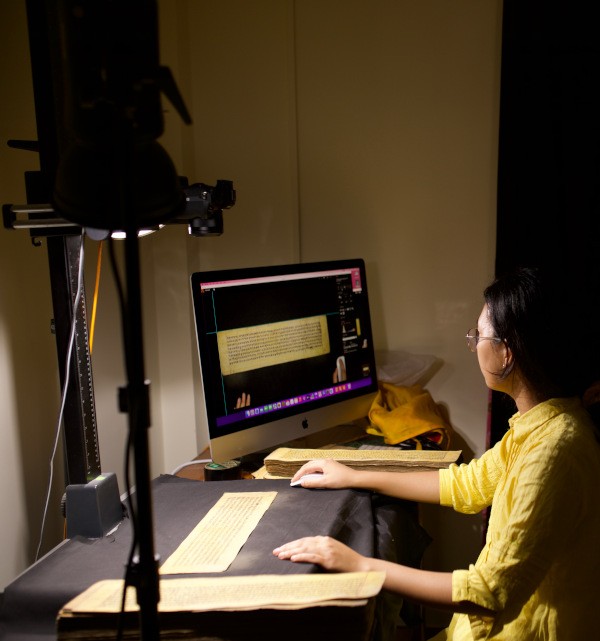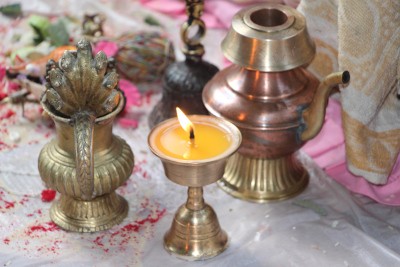Short History
 We have come to know through our understanding of Buddhist history that an enormous amount of Buddhist literature was created in Sanskrit, beginning right after the Buddha’s
We have come to know through our understanding of Buddhist history that an enormous amount of Buddhist literature was created in Sanskrit, beginning right after the Buddha’sAn exhaustive history of the Sanskrit Buddhist literature has long been needed. The reasons behind the scarcity of research into Sanskrit Buddhist literature are many. One of the major reasons is the disappearance of Buddhism from most of India and the unavailability of the original Sanskrit Buddhist works.
In 1824, Mr. Brian Hodgson, a British diplomat, discovered a great number of Sanskrit Buddhist manuscripts in Nepal and reported their existence to the modern world. The existence of these texts was unknown to the rest of the world before his time, and his discovery completely revolutionized the understanding of Buddhism among Europeans in the early part of the nineteenth century. Copies of these works, totaling 381 bundles of manuscripts, were distributed by Hodgson so as to render them accessible to European scholars.
Of these eighty-six manuscripts, comprising 179 separate works, many were presented to Asiatic Society of Bengal. 85 went to the Royal Asiatic Society of London; 30 to the Indian Office Library; 7 to the Bodleian Library, Oxford; 174 to the Société Asiatique, and others reached French scholar Eugene Burnouf. The latter two collections have since been deposited in the Bibliothèque Nationale of France.[1]
With regard to the situation at this time, Prof. Jaya Deva Singh observes in his Introduction to Madhyamika Philosophy:
Books on Mahayana Buddhism were completely lost in India. Their translations existed in Chinese, Japanese and Tibetan. Mahayana literature was written mostly in Sanskrit and mixed Sanskrit. Scholars who have made a study of Buddhism hardly suspected that there were also books on Buddhism in Sanskrit.
Similarly, Suniti Kumar Chatterji writes:
 One great service the people of Nepal did, particularly the highly civilized Newars of the Nepal Valley, was to preserve the manuscripts of Mahayana Buddhist literature in Sanskrit. It was the contribution of Sri Lanka to have preserved for humankind the entire mass of the Pali literature of Theravada Buddhism. This went also to Burma, Cambodia, and Siam. It was similarly the great achievement of the people of Nepal to have preserved the equally valuable original Sanskrit texts of Mahayana Buddhism.
One great service the people of Nepal did, particularly the highly civilized Newars of the Nepal Valley, was to preserve the manuscripts of Mahayana Buddhist literature in Sanskrit. It was the contribution of Sri Lanka to have preserved for humankind the entire mass of the Pali literature of Theravada Buddhism. This went also to Burma, Cambodia, and Siam. It was similarly the great achievement of the people of Nepal to have preserved the equally valuable original Sanskrit texts of Mahayana Buddhism.It is therefore in Nepal that the vast majority of Sanskrit Buddhist documents have been preserved. Regarding the Buddhist literature circulating in Nepal, as many as 20 reports have been published (a list is given in the end of this catalog).
Many of the manuscripts originally preserved in Nepal were carried out of the country by the pioneers of modern Indology. The earliest illustrated Manuscript of the Aṣṭasāhasrikā Prajñāpāramitā, dated 1015 AD, is now in the collection of Cambridge University Library. This manuscript offered new and important material to students of South Asian and Central Asian art history. It is difficult to know exactly when the tradition of producing illustrated manuscripts began; but from available documents it seems that copying and writing such manuscripts began as early as the tenth century in Nepal, i.e. during Narendradeva’s reign (998 A.D.).[2] Features of these manuscripts include miniatures and painted book covers.
 The special, characteristic peculiarity of Newar Buddhism is that its ritual and its sacred literature are written in the Sanskrit language, because of which we can call Newar Buddhism the only surviving form of “Sanskrit Buddhism”. With the collapse of Buddhism in India, some Buddhists escaped from suppression and fled to Nepal. The Newars of the Kathmandu Valley accepted them and their religious and cultural inheritance. The two groups intermarried and their religions and cultures merged to become Newar Buddhism. This happened during a period from the 9th to the 13th century A.D. The Newars have continued to copy Sanskrit manuscripts up to the present day. All Buddhists owe a debt to the Newars, through whose efforts we have been able to study these Sanskrit manuscripts in the present day.
The special, characteristic peculiarity of Newar Buddhism is that its ritual and its sacred literature are written in the Sanskrit language, because of which we can call Newar Buddhism the only surviving form of “Sanskrit Buddhism”. With the collapse of Buddhism in India, some Buddhists escaped from suppression and fled to Nepal. The Newars of the Kathmandu Valley accepted them and their religious and cultural inheritance. The two groups intermarried and their religions and cultures merged to become Newar Buddhism. This happened during a period from the 9th to the 13th century A.D. The Newars have continued to copy Sanskrit manuscripts up to the present day. All Buddhists owe a debt to the Newars, through whose efforts we have been able to study these Sanskrit manuscripts in the present day.Types of Nepalese Manuscript Materials
Palm-leaf Manuscript[3]
 Palm leaves are used for writing and painting because of their thin and flexible qualities. From the first millenium up to the 16th centuries manuscripts were written on palm leaves called Tādapatra. Rolled palmleaf manuscripts are called tāmsuks and have been used mainly for legal deeds. At least 1084 rolled palmleaf manuscripts are held by the National Archives of Nepal alone. These were written fromthe 14th century onwards. One of the oldest among these dates from 1334 CE.
Palm leaves are used for writing and painting because of their thin and flexible qualities. From the first millenium up to the 16th centuries manuscripts were written on palm leaves called Tādapatra. Rolled palmleaf manuscripts are called tāmsuks and have been used mainly for legal deeds. At least 1084 rolled palmleaf manuscripts are held by the National Archives of Nepal alone. These were written fromthe 14th century onwards. One of the oldest among these dates from 1334 CE.
Palm leaf provides an excellent surface for writing and can remain preserved in superb condition. It is usually safe from damage by worms and can be rolled into a small bundle for transport or storage. Most of these manuscripts extant in Nepal are written in Bhujimol script. Most of the historical documents of the early medieval period are found in these palm leaf texts. Rolled palm leaf manuscripts are often placed in small pigeonhole boxes made of straw board and bucrum. These boxes may then be stored inside a steel cabinet rack to protect from dust, dirt and thieves.
Haritalika Paper Manuscript[4]
Haritalika or orpiment is yellow in color, has a crystalline structure, and is odorless, water-insoluble and impervious to inorganic salt. Haritalika is used to coat hand-made paper (Nepali paper) with some binding agent or medium to make it more durable and insect-resistant. Nepali hand-made papers are made from the bark of the Loktā plant, which contains sheets of a cellulose compound. It is creamy in color and usually contains small solid dark brown flecks due to the impurity of the pulp. Microscopic study of this paper clearly indicates that it contains long fibers, arranged irregularly, having a rough surface. Because of this, it offers a premium coating surface for Haritalika paste. The majority of hand-made papers are physically and chemically of good quality, high strength, and have a strong pH factor of 7-9. They have a high degree of tensile strength, folding endurance, and bursting strength.
Thyasaphu Paper Manuscript
These long rectangular folding books or leporellos are mainly employed in circumstances requiring ease of use, such as various rituals, Dhārani recitation and the singing of Stotra or hymns.
Scroll Manuscript
This format is used most often for writing Vamsāvalīs or chronicles, or genealogical records of royal families.
Bound-Book Manuscript
Most bound-book manuscripts are a relatively new, and were most probably imitations of Western examples.
Conclusion
 The importance of inputting these Sanskrit Buddhist texts into a digital format cannot be over-emphasized, for it is in these valuable Sanskrit documents that we have the original version of many of Mahāyāna and Vajrayāna texts that were translated into the Chinese and Tibetan languages, and secondarily, into Korean, Japanese and Mongolian. The corpus of Sanskrit Buddhist literature found in Nepal is comparable to the Pāli literature available today. It is imperative that these Sanskrit originals should be preserved in digital format so that they are accessible to researchers of all kinds.
The importance of inputting these Sanskrit Buddhist texts into a digital format cannot be over-emphasized, for it is in these valuable Sanskrit documents that we have the original version of many of Mahāyāna and Vajrayāna texts that were translated into the Chinese and Tibetan languages, and secondarily, into Korean, Japanese and Mongolian. The corpus of Sanskrit Buddhist literature found in Nepal is comparable to the Pāli literature available today. It is imperative that these Sanskrit originals should be preserved in digital format so that they are accessible to researchers of all kinds.
Since the commencement of the Digital Sanskrit Buddhist Canon (DSBC) project at University of the West in the year 2003, we have received tremendous goodwill from scholars around the world about the worth and success of the project. In addition to the DSBC, starting from the inception of this Rare Buddhist Manuscript Preservation Project in March 2009, Nagarjuna Institute has scanned more than 200 titles of Mss. collected from various monasteries and private collections. Our aim is to gather scans of the entire collection of Mss (numbering more than 1000 titles) in collections which have not been digitized by previous efforts such as those of the Nepal Research Center, Asha Archives and so on. This Rare Buddhist Manuscript Project will be a historic event in the field of digitizing world heritage.
Min Bahadur Shakya
Project Director
Rare Sanskrit Buddhist Manuscript Preservation Project
Nagarjuna Institute of Exact Methods (A Centre for Buddhist Studies)
Chakupat, Lalitpur-10, Nepal
 [1] See R.L.Mitra’s The Sanskrit Buddhist Literature of Nepal, Calcutta (reprint) 1971, p.xxxv-vi.
[1] See R.L.Mitra’s The Sanskrit Buddhist Literature of Nepal, Calcutta (reprint) 1971, p.xxxv-vi.
[2] See Le Népal by Prof. Sylvain Lévi. Here it is stated that on King Narendra Deva’s deathbed, he seemed to have handed over two important things to his daughters: One is his own crown, and the other was a Manuscript of the Prajñāpāramitā scripture.
[3] See the article “Conservation of Rolled Palm leaf Manuscripts (RPLM)” by Mr. Griha Man Singh in “Abhilekha,” published by The Nepal Archives, 1996.
[4] See the article “Haritalika coated envelope is a means of document preservation” by Mr. Griha Man Singh in “Abhilekha”, published by The Nepal Archives, 1994.

 (626) 571-8811 ext.3321
(626) 571-8811 ext.3321 sanskrit@uwest.edu
sanskrit@uwest.edu